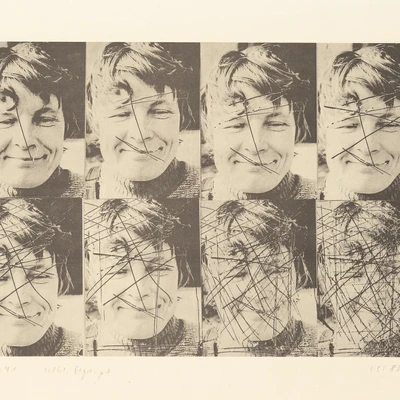Dieter Goltzsche
- * 1934
Life dates
- Artist
Category
Drawing is Not for the Hesitant: Ever Depending on my Mood, Never on a Plan
Dieter Goltzsche, born 1934 in Dresden, found at the famous art academy there an ideal master teacher in the sensual phantasist Max Schwimmer. And that already goes a long way towards describing this free spirit of draughtsmanship, this excitable, farcical, even absurd scribbler and painter, who loved whatever was thorny and grotesque. Line, squiggle, point and splotch – everything is pointed and witty in a way that recalls the French spirit. His motifs – women, landscapes, buildings, flowers, animals – have a laconic effect. Points and line work come together to indicate tortuous life paths, vague color traceries stimulate our fantasies with their willful joy in abstraction. While teaching for many years as professor at the Kunsthochschule Weissensee, Goltzsche also created thousands of drawings and graphic art works: curious amalgams of the spontaneous and the constructed, of the expressive, the lyrical, the satirical – ever depending on his mood, never on a plan. His obsessive drawings, graphic works, and paintings on paper are ageless – altogether they make a refined contribution to the genre of graphic art in Germany. Etching needle, lithograph chalk, wood-cutting knife, and watercolors are Goltzsche’s tools; nature and the city, the human physique, domestic interiors and illustrations of world literature are his themes. Sharp observations and sexual double entendres with a tendency towards the bizarre intermingle on the paper – which may be Japanese paper, Bütten paper, pages from a drawing pad or plain packing paper. There is never anything rigid or fixed in its form, never any over-intellectualized effort at content. Goltzsche was a great admirer of the old master of the medium, Paul Holtz, who once said: Drawing is not for the hesitant. The draughtsman cannot, as the painter can, modulate his possibilities of expression with layers of color. He must see things with one eye, and with the other what lies behind them: similitude, the evanescent. He must work like a spear-thrower; he must decide where he is aiming. This means of course a certain kind of drawing: that with pen and pencil. Goltzsche always steered clear of anything ideological, whether during GDR times or afterwards in the so-called Berliner Republik. Ideology has no business in art, he likes to say with his characteristic laconic undertone. Goltzsche’s art always reflects perceptions borrowed from diverse cultural and aesthetic sources. It is characterized by the tensions of late modernism: poetry and precision, mathematics and musicality, realism and abstraction, spontaneity and construction, flash of insight and prose.
text: Ingeborg Ruthe, translation: Darrell Wilkins
Works by Dieter Goltzsche
Travelling exhibition
Publik machen: 40 Künstler:innen aus dem Bestand des Zentrums für Kunstausstellungen der DDR
Popular keywords
Many more works are hidden behind these terms
